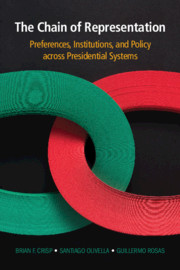Book contents
- Frontmatter
- Contents
- List of Figures
- List of Tables
- Acknowledgements
- Abbreviations
- 1 Studying the Chain of Representation
- 2 Our Solutions to the Challenges of Studying the Chain of Representation
- Part I Stages
- Part II Linkages
- 7 Linkage 1: Electoral Systems
- 8 Linkage 2: Policy-Making Processes (PMP)
- Part III Testing the Chain of Representation
- Appendix Question Wording
- Bibliography
- Author Index
- Subject Index
8 - Linkage 2: Policy-Making Processes (PMP)
from Part II - Linkages
Published online by Cambridge University Press: 10 January 2020
- Frontmatter
- Contents
- List of Figures
- List of Tables
- Acknowledgements
- Abbreviations
- 1 Studying the Chain of Representation
- 2 Our Solutions to the Challenges of Studying the Chain of Representation
- Part I Stages
- Part II Linkages
- 7 Linkage 1: Electoral Systems
- 8 Linkage 2: Policy-Making Processes (PMP)
- Part III Testing the Chain of Representation
- Appendix Question Wording
- Bibliography
- Author Index
- Subject Index
Summary
Institutional variation is not lacking in Latin America's separation of powers system when it comes to endowing legislatures and presidents with policy-making powers. We only witness lack of variation in terms of symmetry across chambers within bicameral systems. Founders never established two chambers and then gave one a significantly different role in the policy-making process than the other. Beyond that limitation, founders have designed an impressive array of policy-making processes across the region.
Keywords
- Type
- Chapter
- Information
- The Chain of RepresentationPreferences, Institutions, and Policy across Presidential Systems, pp. 147 - 168Publisher: Cambridge University PressPrint publication year: 2020

